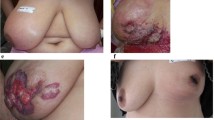Abstract
Objective: The purpose of this study was to use population-based information to describe the demographic and tumor characteristics of inflammatory breast cancer (IBC)– the most aggressive form of this disease.
Methods: IBC cases diagnosed during 1994 through 1998 were reported to 26 population-based cancer registries covering approximately 40% of the US population. Rates were expressed per 100,000 female population and age-adjusted to the 2000 US population. Ninety-five percent gamma confidence limits were estimated for the rates.
Results: Among the 3626 women diagnosed with IBC during 1994–1998, the majority were 40–59 years old. Most tumors were diagnosed at a regional (68.9%) or distant (25.3%) stage and were poorly differentiated (49.4%). The rate of IBC was 1.3 per 100,000 for all races combined. Black women had the highest risk (1.6) and Asian and Pacific Islander women the lowest (0.7).
Conclusions: IBC is an extremely rare form of breast cancer. More precise diagnostic criteria are needed to distinguish it from less aggressive forms of the disease. Future studies should use a population-based design and collect detailed clinical information, including the presence of erythema, edema or peau d'orange appearance of the skin, and other clinical signs of disease.
Similar content being viewed by others
References
Levine PH, Steinhorn SC, Ries LG, Aron JL (1985) Inflammatory breast cancer: the experience of the surveillance, epidemiology, and end results (SEER) program. J Natl Cancer Inst 74: 291–297.
Margoles RG, Fisher B, Hortobagyi H, Bloomer WG (2000) Neoplasms of the breast. In: Bast RC, Kufe DW, Pollock RE, Weichselbaum RR, Holland JF, Frei E, eds. Cancer Medicine, 5th edn. Hamilton, Ontario: B.C. Decker Inc.
Jaiyesimi IA, Buzdar AU, Hortobagyi G (1992) Inflammatory breast cancer: a review. J Clin Oncol 10: 1014–1024.
Chang S, Parker SL, Pham T, Buzdar AU, Hursting SD (1998) Inflammatory breast carcinoma incidence and survival, the surveillance, epidemiology, and end results program of the National Cancer Institute, 1975-1992. Cancer 82(12): 2366–2372.
Taylor G, Meltzer A (1938) Inflammatory carcinoma of the breast. Am J Cancer 33: 33–49.
Haagensen C (1971) Diseases of the Breast, 2nd edn. Philadelphia, PA: Saunders, pp. 576–584.
Singletary SE, Ames FC, Buzdar AU (1994) Management of inflammatory breast cancer. World J Surg 18: 87–92.
Bonnier P, Charpin C, Lejeune C, et al. (1995) Inflammatory carcinomas of the breast: a clinical pathological, or a clinical and pathological definition? Int J Cancer 62: 382–385.
Dahlbeck SW, Donnelly JF, Theriault RL (1995) Differentiating inflammatory breast cancer from acute mastitis. Am Fam Physician 52: 929–934.
Brooks HL, Mandava N, Pizzi W, Shah S (1998) Inflammatory breast carcinoma: a community hospital experience. Am College Surgeons 186: 622–629.
Percy C, Van Holten V, Muir C, eds. (1990) International Classification of Diseases for Oncology, 2nd edn. Geneva, Switzerland: World Health Organization.
Chang S, Buzdar AU, Hursting SD (1998) Inflammatory breast cancer and body mass index. J Clin Oncol 16: 3731–3735.
SEER*Stat 2001(2003) Bethesda, MD: National Cancer Institute. Also available from: URL: http://seer.cancer.gov/seerstat [accessed 2003, January 13].
Fay MP, Feuer EJ (1997) Confidence intervals for directly standardized rates: a method based on the gamma distribution. Statist Med 16: 791–801.
Ries LAG, Eisner MP, Kosary CL, et al. eds. (2002) SEER Cancer Statistics Review, 1973-1999. Bethesda, MD: National Cancer Institute. Also available from: URL: http://www.seer.cancer.gov/csr/1973_1999 [accessed 2002, June 14].
Katz D, Baptista J, Azen SP, Pike MC (1978) Obtaining confidence intervals for the risk ratio in cohort studies. Biometrics 34: 469–474.
O'Malley C, Hu KU, West DW (2002) North American association of central cancer registries: race and ethnicity identifier assessment project. Also available from: URL http://www.naaccr.org, http://www.naaccr.org/Training/files [accessed August 2002].
Ries LAG, Eisner MP, Kosary CL, et al. eds. (2001) SEER Cancer Statistics Review, 1973-1998. Bethesda, MD: National Cancer Institute.
Greene FL, Page DL, Fleming ID, et al. eds. (2002) AJCC Cancer Staging Manual, 6th edn. New York: Springer-Verlag, pp. 221–240.
US Cancer Statistics Working Group (2002) United States Cancer Statistics: 1999 Incidence. Atlanta, GA: Department of Health and Human Services, Centers for Disease Control and Prevention and National Cancer Institute.
Rosenberg HM, Maurer JD, Sorlie PD, et al.(1999) Quality of death rates by race and Hispanic origin: a summary of current research. Vital Health Stat 2(128).
Poe GS, Powell-Griner E, McLaughlin JK, Placek PJ, Thompson GB, Robinson K (1993) Comparability of the Death Certificate and the 1986 National Mortality Followback Survey. Hyattsville, MD: National Center for Health Statistics.
Kolonel LH, Goodman MT (1992) Racial variation in cancer: fact or artifact? J Natl Cancer Inst 84: 916–917.
Hogan H (1993) The 1990 post-enumeration survey: operations and results. J Am Stat Assoc 88: 1047–1060.
Author information
Authors and Affiliations
Corresponding author
Rights and permissions
About this article
Cite this article
Wingo, P.A., Jamison, P.M., Young, J.L. et al. Population-Based Statistics for Women Diagnosed with Inflammatory Breast Cancer (United States). Cancer Causes Control 15, 321–328 (2004). https://doi.org/10.1023/B:CACO.0000024222.61114.18
Issue Date:
DOI: https://doi.org/10.1023/B:CACO.0000024222.61114.18




